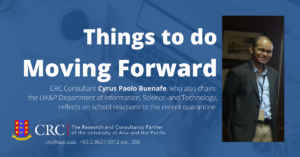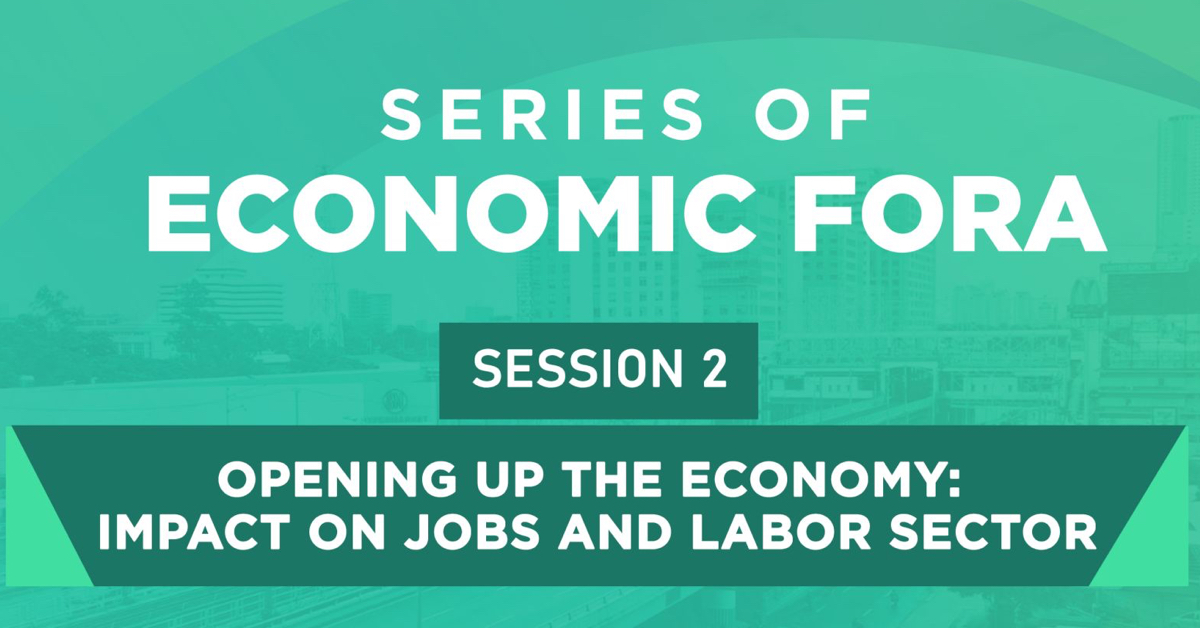CRC Consultant Cyrus Paolo Buenafe, who also chairs the UA&P Department of Information, Science, and Technology, reflects on school reactions to the recent quarantine, and lists suggestions for what schools have to do to respond to this and similar crises.
When the government placed the entirety of Luzon under enhanced community quarantine on March 17, many Philippine institutions were caught as much by surprise as ordinary citizens. And just like most citizens, they had very little time to put together a response.

Manila’s educational institutions were no exception. Having already suspended classes about a week earlier, on March 9, many considered exploring online delivery formats as part of their recovery plan, with some giving their teachers emergency training on how to convert their materials suited for distance learning, and others taking advantage of the fact that they had invested in learning management systems (LMS) before the crisis.
Cyrus Paolo Buenafe, one of the consultants of CRC specializing in computational and technology markets, was paying close attention.
Buenafe, who is concurrently the current Chair of Department of Information Science and Technology of the UA&P School of Sciences and Engineering, has 20 years of experience in the IT service management industry and five years as a teacher and an administrator in a private tertiary academic institution, quickly put together his reflections on the situation.
In the op-ed piece, which can be found here, Buenafe assesses the situation educational institutions found themselves in, and gives suggestions for what else higher education institutions (HEIs) need to do to be more adaptive to crises like the one we now find ourselves in.
And while his reflections were originally meant for educational institutions, they apply just as well to any organizations who are considering a sudden shift from dealing with clients in a physical setting, and then trying to serve them using a virtual or online setup.
School Responses to the Quarantine
Buenafe began by taking note of how quickly events relating to COVID-19 in the Philippines escalated – from the fact that the country was “still reeling from the aftermath of the phreatic explosion of Taal Volcano last January 12,” to the president’s initial suspension of classes within Metro Manila at all levels from March 10 to 14, to the World Health Organization’s declaration of the COVID-19 situation as a pandemic on March 11 to the announcement of a community quarantine within Metro Manila for a whole month on March 12 and the declaration of an enhanced community quarantine through all Luzon on March 17.
He then noted that while some institutions decided simply to forego with the rest of their ongoing term, which had November 2019, numerous other institutions chose to shift to online delivery formats. However, he noted that most of the institutions considering this move were actually not prepared to do so, both from a business operations standpoint and from an academic or pedagogical standpoint.
The first reason Buenafe cited was that given how unprecedented the situation was, most Philippine academic institutions did not have a business continuity program (BCP) which allowed for offsite operations as a contingency or recovery option.
Moving offsite, he noted, meant shifting the needed business operations – in this case, lectures and other instructional activities – to alternative locations, such as the homes of teachers and staff. But unless schools had BCPs in place which incorporated the possibility of doing work at home, this was not an expectation which teachers and staff were ready for.
“I would be willing to make a bet,” says Buenafe, “that most of these employees do not have a conducive working environment at home, having some private space and high-speed internet connectivity. For those who may have these conditions already, it is provided for at their own personal expense and not at the expense of the company – which is expected in any BCP context.”
He points out that some students might not have ideal conditions in their homes and dormitories, either. He mentions two recent surveys which found that only 60% of students have stable internet access. “Unless explicitly mentioned as a requirement for admission,” he says, “students are not expected to have high-speed internet connectivity at homes or dormitories… To proceed online delivery of courses with only 60% capable for accommodating the delivery runs the risk of discrimination.”
The second reason Buenafe cited concerned the pedagogical challenges that need to be addressed when converting a course into an online delivery format – especially if the course was not originally designed to be delivered in an online format, and even more so when the course is already running.
“If the course has already started in a traditional format,” he notes, “there is still this issue of cognitive adjustment. People – teachers and students alike – need to make that mental shift from the traditional format to the online format. As it is, this is already true in a calm situation and this is expected in distance learning literature, but with the crisis such as the COVID-19 pandemic, not only will these people need to make the mental shift but also the psychological stabilization…. What about the teachers? Have they completed their own cognitive adjustments and psychological stabilization to proceed with a new delivery format with little to no prior experience?”
He also notes that not all courses can be converted into online format, since “there are some learning objectives that will require face-to-face or physical interaction, either with the teacher/facilitator or with fellow students. Have you imagined how Physical Education classes will be conducted in an online format?”
As a result, Buenafe says he feels leaders and key influencers of these same institutions who suddenly shifted their courses into the online format might not have been able to scan the situation accurately amidst the pressure “to appear steady when the current reality has been upended in a sudden manner.”
“To be fair,” he proffers, “this is not solely their fault. The present COVID-19 crisis is said to be fluid and so many uncertainties still await. Institutions would have their own organizational dynamics that can exert a huge influence into their decision-making schemes. Not only is the virus novel, but the present situation is also novel and does not have any precedent.”
Still, he says he believes reactively shifting to an online format without adequate preparation “may reflect poor judgment. We owe a lot to our stakeholders to be more prudent and deliberate, despite the overwhelming current events.”
Suggestions for Moving Forward
Finally, Buenafe shared a few suggestions on how educational institutions can move forward, shared here in their entirety:
Physical and psychological safety is paramount. The current crisis is a health crisis and any discussion of whether schools should go online or not starts and ends with whether all stakeholders are actually safe and healthy.
- Find ways to ascertain the safety of all stakeholders – students, teachers, employees, even contractual workers of the institution. Respecting data privacy in the process, leaders should have a directory of contact information of their key personnel, who in turn would have their own directory of contact information of others under them. This is known as a call tree. Use the call tree to connect and assess which of your stakeholders are currently in need of help. Also, the call tree enables leaders to identify folks who are not contactable at that moment.
- Once you have identified those who may need some help, do a triage. Is it a student or an employee in need? What can you do personally to address the situation? Who else would have the same situation? Is there another person who might be in a better position to provide a solution to the issue?
- Also, assess the stability of the location of your stakeholders. Do they have stable utilities (electricity, water, telephone, internet) in their area? What are the gaps identified? These questions are not meant to be exhaustive, but they should give us an idea on how we can address the situation in the quickest time possible.
- Take note of individuals who may be physically fit and having stable facilities but are currently in distress or traumatized by the situation. Seek opportunities to link them to guidance counseling or other professional help so that they can get their bearings straight as soon as possible.
Be inclusive. Make sure that all students are accounted for and their situation properly assessed. Not only students, but equally consider employees, both faculty and staff alike.
- In any crisis, overcommunication is the norm. Do not rely on a single channel or mode of communication in sending your advisories. And because you are relying on multiple channels, keep the message short and straight to the point. The extra effort and costs you may incur in making communication redundant are worth the price of avoiding confusion, discrimination and even potential lawsuits.
Draft a quick recovery plan. While it may be possible that schools do not have a detailed plan in place prior to the crisis, realize and appreciate that this is no longer business as usual and something else needs to happen to move forward.
- Ask yourselves: What is the minimum set of conditions required in order to proceed with what is essential? This will constitute your skeletal workforce. It may be important to identify key personnel from the support functions. Using this key idea, one begins to appreciate the value of whether it is important to move the delivery format of courses to online. Is that institution certain that all their needed stakeholders are safe? Can they actually do their work well?
- It might be good for academic programs to revisit their requirements matrix or a list of all requirements in all courses within that program with all their corresponding deadlines. Examine the original workload distribution and see whether the workload is still possible in light of the new situation.
- Lastly, consider the scenario of accepting the risk of not completing the course according to the original set of learning objectives, instead of the scenario of mitigating the risk by suddenly and reactively shifting to online delivery of the course. When doing risk acceptance, understand the full impact. Definitely, the risk profile of each institution can vary, but if one simply looks at the risk of not fulfilling certain course objectives due to the abrupt interruption, it might make more sense to address the impact after the crisis (for example, make-up sessions) rather than during the crisis (for example, online delivery).
“The coronavirus situation is not only a temporary blip in the system,” Buenafe concludes. “It caused serious and far-reaching effects that will change the landscape of businesses and organizations in the Philippines, including educational institutions. For sure, it has impacted organizational culture and cohesiveness. There might be legal and even political ramifications once the dust settles. But like all other crises, this is more of an opportunity for us to look for means and ways to improve how we deliver our services, including educational institutions.”
“Surely, schools will start to appreciate the discipline of simple risk management, perhaps elevating their practices to come up with a full business continuity program. What is important right now, at short term, is that people are safe and secure. Because if they are not, there is no point in discussing anything else once we are past this crisis.”







